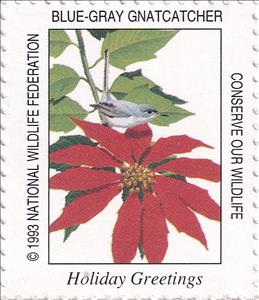Stamp: Blue-gray gnatcatcher (United States of America 1993)
Blue-gray gnatcatcher (United States of America 1993)
01 January (United States of America ) within release National Wildlife Federation goes into circulation Stamp Blue-gray gnatcatcher face value None No Face Value
| Stamp Blue-gray gnatcatcher in catalogues | |
|---|---|
| Colnect codes: | Col: US SPNWFE5302/05 |
Stamp is square format.
Stamp from full pane with NWF print number E5302.Also in the issue National Wildlife Federation:
- Stamp - Snow Geese face value None;
- Stamp - Blue-gray gnatcatcher face value None;
- Stamp - Bob white face value None;
- Stamp - Ermine face value None;
- Stamp - Mountain goat face value None;
- Full Pane - National Wildlife Federation Christmas stamps 1993 face value None;
- Stamp - Snow goose face value None;
- Stamp - White-tailed deer face value None;
Stamp Blue-gray gnatcatcher it reflects the thematic directions:
Birds (Aves), a subgroup of Reptiles, are the last living examples of Dinosaurs. They are a group of endothermic vertebrates, characterised by feathers, toothless beaked jaws, the laying of hard-shelled eggs, a high metabolic rate, a four-chambered heart, and a strong yet lightweight skeleton. Birds live worldwide and range in size from the 5 cm (2 in) bee hummingbird to the 2.75 m (9 ft) ostrich. They rank as the class of tetrapods with the most living species, at approximately ten thousand, with more than half of these being passerines, sometimes known as perching birds. Birds are the closest living relatives of crocodilians.
A flower, sometimes known as a bloom or blossom, is the reproductive structure found in plants that are floral (plants of the division Magnoliophyta, also called angiosperms). The biological function of a flower is to effect reproduction, usually by providing a mechanism for the union of sperm with eggs. Flowers may facilitate outcrossing (fusion of sperm and eggs from different individuals in a population) or allow selfing (fusion of sperm and egg from the same flower). Some flowers produce diaspores without fertilization (parthenocarpy). Flowers contain sporangia and are the site where gametophytes develop. Many flowers have evolved to be attractive to animals, so as to cause them to be vectors for the transfer of pollen. After fertilization, the ovary of the flower develops into fruit containing seeds. In addition to facilitating the reproduction of flowering plants, flowers have long been admired and used by humans to beautify their environment, and also as objects of romance, ritual, religion, medicine and as a source of food.


